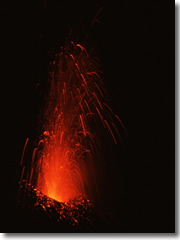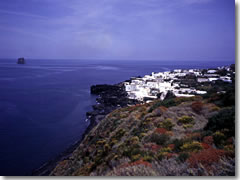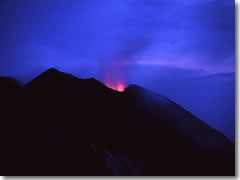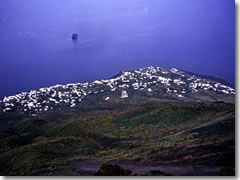- Places
- Plans
- Itineraries
- Experiences

It erupts explosively two to three times an hour, spewing lava rocks and ash in a tight cone as high as 3,000 feet into the air.
It is quite dramatic—but you really need to stand up on the lip of the crater to get the full effect, preferably at night.
How to pronounce Stromboli
Unlike the Italian-American snack (which ironically, you can't find on the real Stromboli), the name of the island is pronounced with the stress on the first syllable: STROHM-bo-lee. Also, that's a long "o" as in chrome (not a short "o" as in Strom Thurmond).Stromboli looks very much the part: a forbidding, conical mountain rising suddenly from the azure waters, with smoke trailing from the summit and a tiny, whitewashed community of cube houses clinging to one side where some 400 hardy souls live (primarily off tourism).
Stromboli is immortalized both as the spot where Jules Verne's adventurers popped out at the end of their Journey to the Center of the Earth, and as the site and title of the 1950 Rossellini film Stromboli, during the filming of which the director and his star Ingrid Bergman had a scandalous off-camera love affair.

A view back to the main town during the hike up Stromboli.Officially, you cannot ascend without a guide, but the rule isn’t really enforced unless the volcano is having a particularly dangerous fit, as it does from time to time.
Even the scientists who constantly monitor the belly of this beast have, at best, a few hours' notice before a big eruption. Usually, there is no warning. Just explosions of magma.
In other words: hikers beware.
The hike up is a strenuous three to five hours; follow the red-and-white blazes. In daylight you can't see the glow of lava in the eruptions—it just looks like fountains of mud, really. Against the night sky, however, the fireworks are spectacular.
Most people start up in late afternoon to arrive before sundown, spend the night sitting on top, and descend at first light. Do not attempt to walk back down after dark. Bring at least two liters of water per person, and if you're spending the night, a picnic, all your warm clothes, a poncho with a hood, and a flashlight.

The volcano at dawnDon't go up if it's going to rain—you’ll be miserable. It gets cold and very windy on top, even in summer, and the pumice dust blows continuously; you'll need to put that poncho on backward and pull the hood over your face if you want to lie down and avoid getting pumice dust in your ears, eyes, nose, and mouth.
Stick to the outer ridge of the ancient, enormous crater that surrounds the two smaller, active ones—still a mere couple of hundred feet from the eruptions. Every year a dumb tourist or two gets hurt or killed by raining lava when they venture up on the lip of the active crater.
Descend the way you came.
Guided hikes arrive at the top for sunset, spend about half an hour at the top after dark (time for at least one good eruption), then lead you sliding back down a pumice chute on the back side of the mountain. Do not attempt this unmarked descent without the guide.

For more info:
www.comunelipari.it
www.aasteolie.191.it
www.eolieproloco.it
www.lipari.com
Stromboli is the most difficult of the major Aeolian Islands to get to, but also the most dramatic and potentially rewarding. I'd give it two full days—one to get out here and climb to the top of the crater to spend the night, and a second to get back down and spend relaxing on the beach and recovering from the night spent on top. This, obviously, means a third days need to be budgeted to leave the island and get elsewhere (either another Aeolian or back to the Sicilian mainland). (More tips on spending from one to four days exploring the Aeolian islands).
The island shuts down from November through Easter. Don't even bother.
You can only get to Stromboli by boat—a hydrofoil (aliscafo) will be twice as fast, twice as expensive, and half as romantic as a ferry (traghetto).
There's no tourist office on Stromboli, but the provincial website for Lipari and the Aeolian Islands is packed with good info: www.comunelipari.it. There also great info on the islands' Pro Loco site (www.eolieproloco.it) plus on www.lipari.com and the official (but buggy) www.aasteolie.191.it.
There are permanent tourist offices on Lipari at Corso V. Emanuele 202 (tel. +39-090-988-0095) and in Milazzo on Piazza Caio Duilio (tel. +39-090-922-2865).
For a vulcanlogists take on Stromboli, try www.geo.mtu.edu/~boris/STROMBOLI-volcano.html. Another good unofficial site is Stromboli on-Line (www.stromboli.net).
Share this page
Search ReidsItaly.com
For more info:
www.comunelipari.it
www.aasteolie.191.it
www.eolieproloco.it
www.lipari.com
Hotels on Stromboli
www.booking.com
www.airbnb.com
www.bedandbreakfast.com
www.hostelworld.com